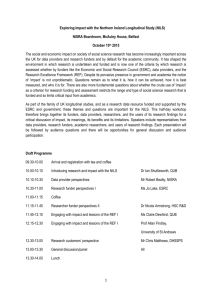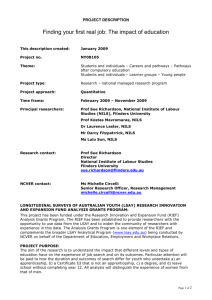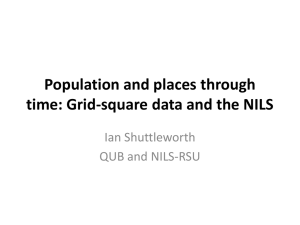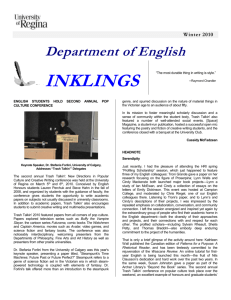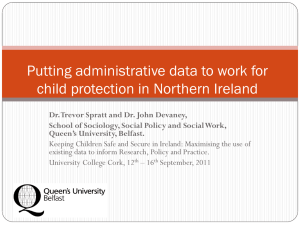Ethnic Challenges to the Nation State
advertisement
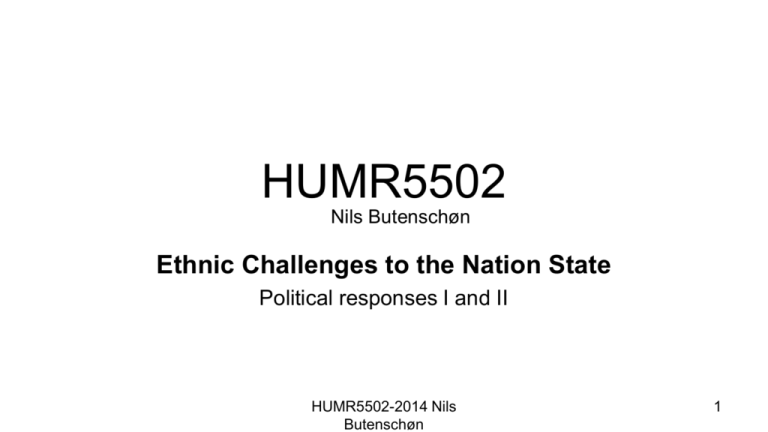
HUMR5502 Nils Butenschøn Ethnic Challenges to the Nation State Political responses I and II HUMR5502-2014 Nils Butenschøn 1 Thematic rights involved • States: – Sovereignty – Territorial integrity • Groups: – – – – Self-determination Autonomy Collective rights Minority rights • Individuals: – Human rights • Which instruments are available for the realisation of these rights? • Our focus: How to build democracy and human rights protection in deeply divided societies HUMR5502-2014 Nils Butenschøn 2 Two lectures • • Political responses I: Theory. The ‘citizenship approach’ and international human rights law. Concepts and approaches. Political responses II: The Case of Israel/Palestine. HUMR5502-2014 Nils Butenschøn 3 Lecture 1: Two major questions (A) The political system: How does it deal with diversity? (B) What are the consequences in terms of the respect for and the protection and fulfillment of human rights? • Framework of analysis: A citizenship approach: What does it imply? HUMR5502-2014 Nils Butenschøn 4 WHY-questions • Why does diversity appear as a problem in some political systems, but not in other systems? Why do political systems (governments) deal with diversity in different ways? (Ghai, Ethnicity; Lijphart). HUMR5502-2014 Nils Butenschøn 5 HOW-questions • How can insights into these questions help us understand the nature of ethnic conflicts that we observe; both what they seem to have in common, and what distinguish them as unique historical phenomena. (Kymlicka). • How can we on this basis be helped in suggesting strategies, based on human rights standards, for solving the kinds of problems that are caused by diversity? (Ghai, Public Participation; Lijphart; Butenschøn) HUMR5502-2014 Nils Butenschøn 6 State strategies, overview • States can use its monopoly of coercive power to: • (a) Centralise state institutions in order to protect the hegonomy of the ruling elite. • (b) Centralise in order to impose solutions to conflicts between socio-cultural groups in society. • (c) Decetralise in order to allow sub-national autonomy and thereby stabilise the state structure. • (d) Decentralise to prevent unified opposition to the central government (‘divide and rule’). HUMR5502-2014 Nils Butenschøn 7 The citizenship approach • The study of the contractual relationship (in the broadest possible meaning of contractual) between the state and the inhabitants under its jurisdiction (Butenschøn). • Under what conditions are such relationships created, how are rights and obligations codified and perceived by the parties, what are the modalities for changing the terms, and what instruments of retribution are available to the parties in case of conflict? HUMR5502-2014 Nils Butenschøn 8 The citizenship approach • These questions direct our attention towards three basic dimensions of state formations: – The normative foundation (state idea, ideology) – The field of actors and their strategies – Instruments of power available to actors (rulers, opposition, individuals) HUMR5502-2014 Nils Butenschøn 9 The politics of citizenship • “The politics of citizenship” in a given country is the dependent variable and reflect the dynamics created by the interplay between the three dimensions; it is an analytical gateway to insight into the dynamics of regime formation. • Discuss empirical examples. HUMR5502-2014 Nils Butenschøn 10 The politics of citizenship • Since citizenship is such an important right – it is the right to have rights in a state – and since there is no legally binding convention on citizenship, many governments seek to limit the access to citizenship through mechanisms of inclusion and exclusion. HUMR5502-2014 Nils Butenschøn 11 A cross-diciplinary approach • Legal and social science approaches: Analytical interdependence in the search for a more complete picture • The power of citizenship: Best known by those who are denied it. The right to have rights. To the extent that citizenship rights enable a person to enjoy other rights, the right to a citizenship must be considered a basic human right. • Conclusion: A great empirical variety hidden behind formal state sovereignty. HUMR5502-2014 Nils Butenschøn 12 Nation-state and citizenship • The idea of the nation-state. Each ‘nation’ should have the right to be organised as a sovereign people within its own ‘state’ • The European historical context. United Nations • The nation-state: A universal model? A democratic model? Can you mention other models? HUMR5502-2014 Nils Butenschøn 13 A process of gradual socio-political integration (T.H. Marshall) • 1. Civil citizenship: Equality before the law (18th century) • 2. Political citizenship: Political participation (19th century) • 3. Social citizenship: Social equality (20th century) • Modern citizenship is “inclusive and complete”. HUMR5502-2014 Nils Butenschøn 14 Principles of distribution of rights (Butenschøn 2000:17) Singularism Discriminatory: Hegemonic systems (e.g., ethnocracy) Ethno-centric state-idea Pluralism Non-discriminatory: Collective equality; Systems of power-sharing (E.g., Consociational democracy) Ethno-neutral state-idea Universalism Non-discriminatory: Majoritarian democracy. (E.g., Westminster model) Integrative state idea Group-based distribution of rights Individually based distribution of rights HUMR5502-2014 Nils Butenschøn 15 Political Organisation of State Territories. A Typology (Butenschøn 2000:18) Territorial Principles Constitutional Principles The Unitary State The Non-Unitary State Separate Territories Singularism Ethnocratic systems Imposed/dominated self rule Ethnic ”Homelands” Pluralism Consociational systems Cantonization, ethnic federation Partition/separate states along ethnic lines Universalism Majoritarian systems Regionalisation, functional federation Partition/separate states along functional lines HUMR5502-2014 Nils Butenschøn 16 The idea of Autonomy • Autonomy as federalism and other territorial arrangements (Yash Ghai) • Ethnic autonomy – The problem of asymmetry – The dilemma – Consociational democracy HUMR5502-2014 Nils Butenschøn 17 Discussion • The politics of citizenship: Cases • Choose a country, identify its political system in terms of the model, discuss human rights implications and prospects for alternative developments/outcomes. HUMR5502-2014 Nils Butenschøn 18 Lecture 2: Israel/Palestine as a case • Let’s start with a figure that can represent some major dimensions relevant to my lectures. (Netx slide). HUMR5502-2014 Nils Butenschøn 19 Alternative demographic foundations for claims of selfdetermination in Israel/Palestine HUMR5502-2014 Nils Butenschøn 20 Israel/Palestine: How to define the demos • Six demographic entities involved in the claims of the right to self-determination in the territory: • The Zionist claim: The Jewish people (Jewish diaspora + Yishuv + settlers) • The Palestinian claim: The Palestinian people (Palestinian diaspora + Palestinians in Israel + Palestinians in Occupied Palestinian Territory). • Who should be included, who should be excluded within which borders? Who has the right to decide? • Problem: Demographic realities as constantly changing. HUMR5502-2014 Nils Butenschøn 21 HUMR5502-2014 Nils Butenschøn 22 Palestinian demographics • The estimated number of Palestinians all over world by the end of 2014 is 12.9 million distributed as follows: 4,1 million in the OPT (37.9%); 1.4 million (11.2%) in Israel; 3.8 million (29.4%) in Jordan; 0,6 million (4.6%) in Syria. • In OPT: 3,1 million (63.0%) in West Bank and 1.8 million (37.0%) in Gaza Strip. HUMR5502-2014 Nils Butenschøn 23 The regugees • 1949: 711.000. These and their descendants are registred at United Nations Relief and Works Agency for Palestine Refugees in the Near East UNRWA: http://www.unrwa.org/palestine-refugees • Today: About 5 million. About 1/3 still live in refugee camps in Jordan, Lebanon, Syria and OPT. The rest live in towns and villages in these countries. HUMR5502-2014 Nils Butenschøn 24 Palestinian demographics, distribution. HUMR5502-2014 Nils Butenschøn 25 Jewish demographics http://www.simpletoremember.com/vitals/world-jewish-population.htm Jewish demographics World Jewish Population 13.3 million Diaspora 8.35 million 63% N. America 6.5 million 46% Eur op e 1.6 milli on 12 % S. America, Africa, Asia, Australia Israel 4.95 million 37% 5% HUMR5502-2014 Nils Butenschøn 26 The State of Israel. Demographics 2013 Group Population Proportion of total Growth rate 6,119,000 Jews Of which: 5,162,500 MainstreamHaredi 956,500 75.0% 1.7% 63.3% 11.7% 1.2% 5.0% Arabs 1,688,600 20.7% 2.2% Total 8,157,300 1.9% HUMR5502-2014 Nils Butenschøn 27 HUMR5502-2014 Nils Butenschøn 28 A comparison • South Africa under Apartheid. Homelands HUMR5502-2014 Nils Butenschøn 29 Palestine: Some aspects of international law • The right to self-determination – UDHR, Art 21: "the will of the people shall be the basis of the authority of government." – An individual and collective right to "freely determine . . . political status and [to] freely pursue . . . economic, social and cultural development.“ (ICCPR and ICESCR, common Art 1). – A norm of jus cogens (the highest rules of international law) and erga omnes ("flowing to all“: the international community is under a mandatory duty to respect it in all circumstances in their relations with each other). – Self-determination and “the politics of avoidance”. An arena for intense politization (national liberation vs. state integrity, freedom struggle vs. terrorism, etc). HUMR5502-2014 Nils Butenschøn 30 Palestine and de-colonialisation • «Perfect» and «imperfekt» de-colonisation. – The Declaration on the Granting of Independence to Colonial Countries and Peoples (GA Res 1514 XV, 1960). – “Perfect” de-col.: Full and orderly transition from the colonial power to a new independent state. – “Imperfect” de-col.: de jure but not de facto; leaving the colonial territory with intractable conflicts. – Palestine as a case of imperfect de-colonialisation. HUMR5502-2014 Nils Butenschøn 31 Palestine and the history of imperfect de-colonisation • • • • • • • • Pre 1948: Mandate system; Balfour Declaration. 1947 Partition Plan: Two-state solution (GA Res 181). 1948: Right of Return (GA Res 194). 1967 and The Green Line (SC Res 242). 1993/1995: Oslo Accords. 2002: SC Res 1397 («a vision of two states»). 2004 ICJ Advisory Opinion on The Wall. 2011-2012: The quest for UN recognition HUMR5502-2014 Nils Butenschøn 32 Pre-1948:Sykes-Picot 1916 • Blue: French • Red: British • Yellow: Joint HUMR5502-2014 Nils Butenschøn 33 Balfour Declaration 1917 • British occupation 1917-1918 • League of Nations mandate1920 • Unsolved: – What is a ‘National Home’? – Borders? – Status and rights of indigenous people? HUMR5502-2014 Nils Butenschøn 34 The Partition Plan 1947 and postwar situation • Two states within an economic union. • 1948-49: Cease fire agreements, not peace agreements. The cease fire lines known today as ‘The Green Lines’ or ‘1967 borders’. • Resolution 194: The Right of Return. HUMR5502-2014 Nils Butenschøn 35 1967 and the principle of ‘Peace for territory’ (SC Res 242) • SC Res 242: «the inadmissibility of the acquisition of territory by war and the need to work for a just and lasting peace in which every State in the area can live in security” – Withdrawal of Israeli armed forces from territories occupied in the recent conflict; – respect for and acknowledgement of the sovereignty, territorial integrity and political independence of every State in the area and their right to live in peace within secure and recognized boundaries free from threats or acts of force; – For achieving a just settlement of the refugee problem. HUMR5502-2014 Nils Butenschøn 36 The Oslo Accords 1993/1995 • Oslo I: A declaration of principles: Conflict to be solves by peaceful means; The establishment of a Palestinian Authority in parts of the territory; Political institutions and elections; Permanent status questions to be negotiated within three years. • Oslo II: Division of OPT in A, B, and C status. HUMR5502-2014 Nils Butenschøn 37 The ICJ Advisory Opinion 2004 • Defining all post 1967 settlements as illegal; The route of the wall in OPT is illegal. • Until now, no or little practical importance because Palestine is not a state.The admission of Palestine as a «non-member observer state» in the UN might change this. HUMR5502-2014 Nils Butenschøn 38 • • • • • • • The Palestinian bid for recognition of statehood Montevideo Convention 1933 PA letters and application UN Security Council rules GA rules Positions and alliances/negotiations Why did it fail? The 2012 successful bid for status as NonMember Observer-State HUMR5502-2014 Nils Butenschøn 39 Discussion: Prospects • If not a two-state solution, what then? • Israel-Palestine as a unified state based on power-sharing between autonomous Israeli ans Palestinian entities (cfr. BosniaHerzegovina)? • A federation (cfr. UN 1947 Minority proposal)? HUMR5502-2014 Nils 40 Butenschøn
